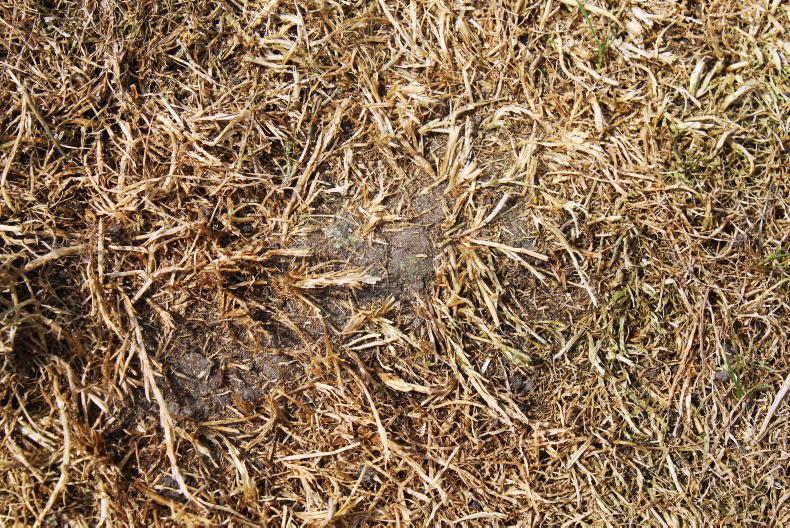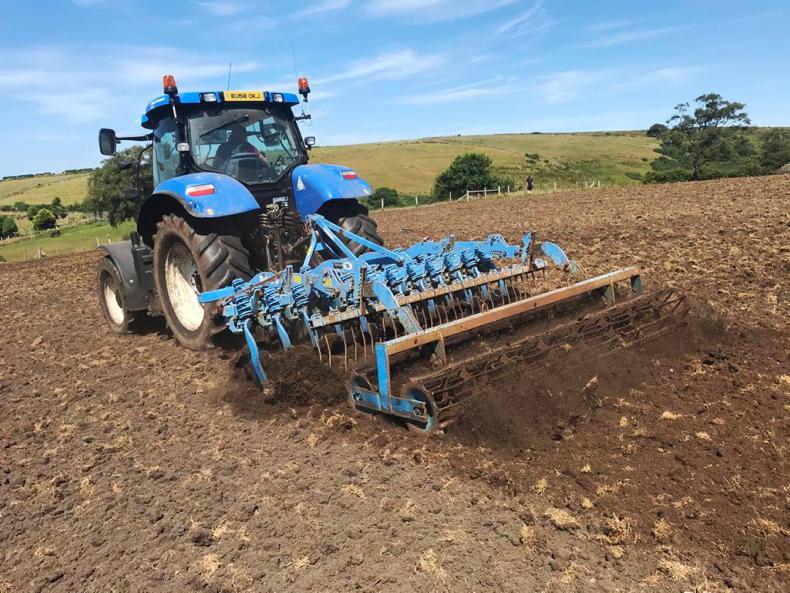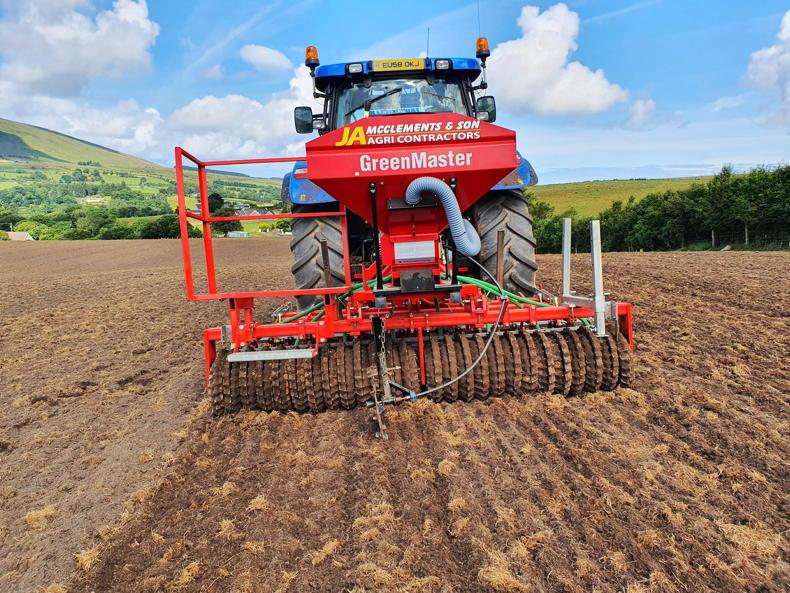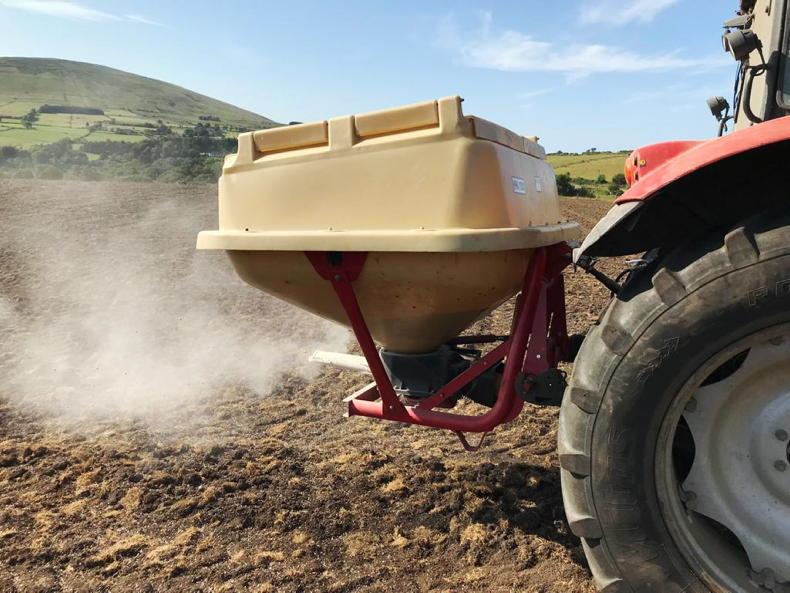Karol and Peter McCaughan took full advantage of the drier conditions in late July to reseed grazing swards on their upland/hill farm outside Ballycastle, Co Antrim.
Seven acres have now been sown out in new grass using a minimum tillage approach, as ploughing on the hill was a less practical option for the McCaughan brothers.
The area reseeded is primarily used for grazing their upland ewe flock, although surplus grass has been baled for silage since joining the programme.
The majority of the work was carried out using local contractors and conditions were ideal during each task. Outlined are some of the main tasks carried out.
The old sward was burned off in early July and allowed to die back. After 10 to 12 days, ewes and lambs were penned on to the old sward to graze off as much of the grass as possible.
This reduced the amount of residual trash left on the field before starting to reseed. Thankfully, there was no drainage work or other field improvement work required.

Picture 2 - Tight grazing meant there was less trash to deal with when reseeding.
The field has been soil tested and pH is 6.1. A bag/ace of granulated lime was broadcast, as the residue from the dead sward can make the seedbed acidic.

Picture 3 - The field was powerharrowed and disced on 23 July to create a clean seed bed.
The field was cultivated with a power harrow on Friday 23 July, to break up the old sward and create a suitable seedbed. On the same day, the field was also worked over with a set of discs and a crumble bar.

Picture 4 - Grass seed was sown out on 3 August using a local contractor.
As the weather broke shortly after the field was disced, sowing grass seed was delayed until 3 August.
The field got a final run with a power harrow before grass seed was sowed out using a Guttler seed drill. The grass mix is outlined below.

Picture 5 - The field has been soil tested. The soil pH is 6.1 while P and K are above optimum. Granulated lime and nitrogen were applied to encourage the new grass to establish.
After grass seed was sown out, fertiliser was applied to help get new grass established. Soil analysis indicates the field is at index 3 and index 4 for P and K, so only straight nitrogen was used to feed the reseed.
Clover was included in the mix and a clover-safe spray will be used to control perennial weeds. Once the sward has properly established, the new grass will be managed with sheep to encourage plants to tiller out.
Grass seed mix
The grass mix used by Karol and Peter is outlined as follows:
3kg Callan – late-heading diploid.3kg Glenarm – late-heading diploid.3kg Drumbo – late-heading diploid.3kg Ballintoy – late-heading tetraploid.2kg Aberdai – medium-leaf clover.Date for diary
The NI Sheep Programme will hold a webinar on Thursday 12 August at 8pm, with the focus of the evening on the problem of wormer resistance and its impact on lamb performance.
Access the event here.
Read more
Mandatory EID cattle tagging from 2022
Favourable sheep market set to stay as IFA urges farmers to ‘sell hard’
Karol and Peter McCaughan took full advantage of the drier conditions in late July to reseed grazing swards on their upland/hill farm outside Ballycastle, Co Antrim.
Seven acres have now been sown out in new grass using a minimum tillage approach, as ploughing on the hill was a less practical option for the McCaughan brothers.
The area reseeded is primarily used for grazing their upland ewe flock, although surplus grass has been baled for silage since joining the programme.
The majority of the work was carried out using local contractors and conditions were ideal during each task. Outlined are some of the main tasks carried out.
The old sward was burned off in early July and allowed to die back. After 10 to 12 days, ewes and lambs were penned on to the old sward to graze off as much of the grass as possible.
This reduced the amount of residual trash left on the field before starting to reseed. Thankfully, there was no drainage work or other field improvement work required.

Picture 2 - Tight grazing meant there was less trash to deal with when reseeding.
The field has been soil tested and pH is 6.1. A bag/ace of granulated lime was broadcast, as the residue from the dead sward can make the seedbed acidic.

Picture 3 - The field was powerharrowed and disced on 23 July to create a clean seed bed.
The field was cultivated with a power harrow on Friday 23 July, to break up the old sward and create a suitable seedbed. On the same day, the field was also worked over with a set of discs and a crumble bar.

Picture 4 - Grass seed was sown out on 3 August using a local contractor.
As the weather broke shortly after the field was disced, sowing grass seed was delayed until 3 August.
The field got a final run with a power harrow before grass seed was sowed out using a Guttler seed drill. The grass mix is outlined below.

Picture 5 - The field has been soil tested. The soil pH is 6.1 while P and K are above optimum. Granulated lime and nitrogen were applied to encourage the new grass to establish.
After grass seed was sown out, fertiliser was applied to help get new grass established. Soil analysis indicates the field is at index 3 and index 4 for P and K, so only straight nitrogen was used to feed the reseed.
Clover was included in the mix and a clover-safe spray will be used to control perennial weeds. Once the sward has properly established, the new grass will be managed with sheep to encourage plants to tiller out.
Grass seed mix
The grass mix used by Karol and Peter is outlined as follows:
3kg Callan – late-heading diploid.3kg Glenarm – late-heading diploid.3kg Drumbo – late-heading diploid.3kg Ballintoy – late-heading tetraploid.2kg Aberdai – medium-leaf clover.Date for diary
The NI Sheep Programme will hold a webinar on Thursday 12 August at 8pm, with the focus of the evening on the problem of wormer resistance and its impact on lamb performance.
Access the event here.
Read more
Mandatory EID cattle tagging from 2022
Favourable sheep market set to stay as IFA urges farmers to ‘sell hard’










 This is a subscriber-only article
This is a subscriber-only article










SHARING OPTIONS: